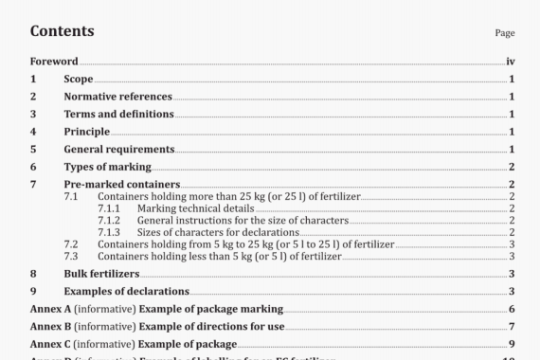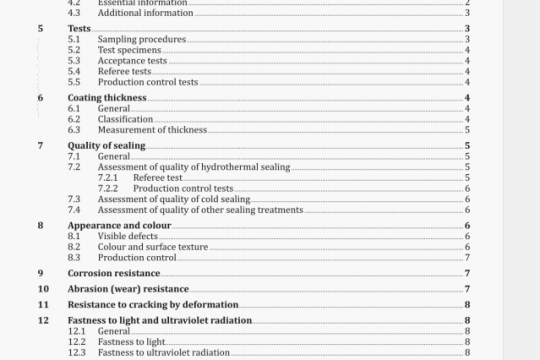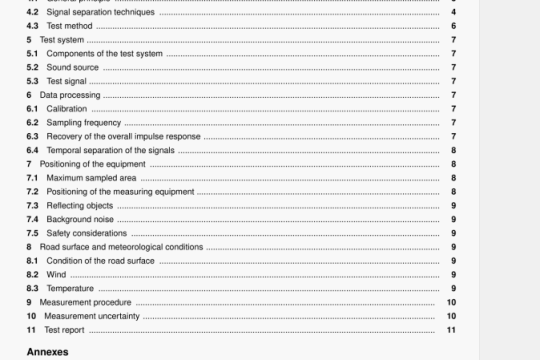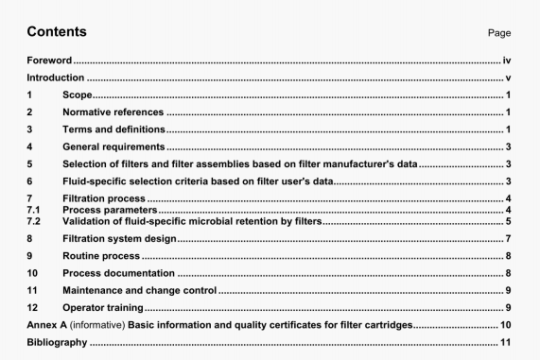ISO 5267-2:2001 pdf download
ISO 5267-2:2001 pdf download.Pulps – Determination of drainability—Part 2:
“Canadian Standard” freeness method.
4 Principle
Drainage through a fibre mat formed during the test on a perforated screen plate of a given volume of an aqueous pulp suspension into a funnel provided with a bottom and a side orifice. Determination is made of the volume of filtrate discharged from the side orifice. The volume of the discharged filtrate, in millilitres, is the “Canadian Standard1’ freeness of the pulp.
5 Apparatus
Ordinary laboratory apparatus and:
5.1 “Canadian Standard” freeness tester, as described in annex A.
NOTE Instructions for maintenance of the apparatus are given in annex B. Details of the Calibration Service for the apparatus are given in annex C. Information concerning authorized laboratories is also given in annex C.
5.2 Measuring cylinders, calibrated in millilitres and capable of measuring volume with an error less than 1,0 ml
for volumes up to 100 ml; an error less than 2,0 ml for volumes between 100 ml and 250 ml; and an error less than
5,0 ml for volumes above 250 ml.
5.3 Balance, capable of reading accurately to 0,01 g.
NOTE Although for the determination of the mass of the side orifice discharge a balance of 0,1 g accuracy is sufficient, for the determination of stock concentration the necessary accuracy of the balance is 0,01 g.
5.4 Standard water, for physical testing, as described in ISO 14487.
6 Preparation of sample
As the drainage of a pulp suspension is affected considerably by dissolved solids and the pH of the water used in the determination, standard water in accordance with ISO 14487 shall be used throughout the test.
A sample of an aqueous suspension of the disintegrated pulp shall be taken. If the concentration is not known exactly, the suspension shall be thickened or diluted to approximately 0,32 % by mass using standard water, and the stock concentration determined in accordance with ISO 4119. Then the suspension shall be diluted to a stock concentration of 0,30 % ± 0,01 % by mass and the temperature adjusted to 20,0 °C ± 0,5 °C (see note 3). Throughout the preparation of the sample, care shall be taken to avoid the formation of air bubbles in the suspension.
NOTE 1 With time, an aqueous pulp suspension withdrawn from the stock preparation system or laboratory pulp evaluation equipment can undergo a change in freeness. To avoid the effect of this reversion phenomenon, pulp suspensions subjected to testing more than 30 mm after sampling shall first be treated in the disintegration apparatus for 6 000 revolutions of the propeller at 1 2 % to 1,5 % concentration.
NOTE 2 The test result is sensitive to the quantity of pulp fines, or “crill”, in the suspension. Thickened pulp samples may lose some of this fibre fraction. To avoid such losses during the course of thickening, the filtrate shall be recirculated through the pulp pad until the filtrate is clear and the pulp redispersed by disintegration, as described in note 1. This procedure shall be used to concentrate dilute pulp suspensions to the stock concentration required for the freeness test.
NOTE 3 Where necessary (e.g. process control), a temperature other than 20 °C may be used but it is not in accordance with this part of ISO 5267 and must be reported. The correlation tables presented in this part of ISO 5267 (informative annexes D and E) were developed from groundwood freeness evaluation studies. The accuracy of the correction tables for chemical pulp freeness evaluation has not been determined.
NOTE 4 In some applications, e.g. process control, it may be convenient to accept larger deviations than 0,01 % for stock concentration and ± 0,5 °C for temperature. The volume measured should be corrected with the aid of correction tables given in annexes D and E. The result so obtained does not conform to this part of ISO 5267.
7 Procedure
Clean the funnel and drainage chamber of the “Canadian Standard”freeness apparatus (5.1) thoroughly, andfinally rinse with water. Place the drainage chamber in position. Adjust the temperature of the apparatus by rinsingwith water at 20,0 C±0,5C (see note 3 in clause 6).




